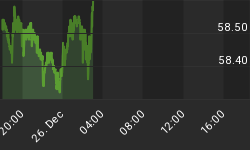Ultimately, supply has to equal demand. That reality most of us accept. We can, for example, only consume the amount of adult beverage residing in the refrigerator. Once we have done so, no level of wishing will provide any adult beverages. In a fair world, too, we would all have the same amount of adult beverages in our refrigerator at any point in time. And as we write those words, we wonder why government does not do something about adult beverage inequality. And as we wrote those words, second thoughts developed. Any attempt by governments to redress adult beverage inequality would result in all having less adult beverages. Certainly, that would be undesirable.
Extending those thoughts further brings us to the realization that only in government does the supply of money not have to equal the demand for money. Everywhere else, the supply of money dictates what can be consumed. Everywhere on earth, money is in balance. That reality of balance may be about to visit the U.S. Treasury. Those government agents residing there need to raise more than $2 trillion in the coming year from gullible global investors to finance Obama regime's plethora of pork and populism.

Our first graph is all about money, something about which greedy Gold bugs like to think. The black squares are a three-month moving sum of the U.S. trade deficit. Each month the U.S. buys from the rest of the world more than it sells to the rest of the world. Any balance due is paid with dollars, the fiat money of the U.S. Due to oil prices having fallen and the massive recession in which the U.S. finds itself, that trade deficit has been declining. In short, things are so bad U.S. consumers can not afford to buy as much as they previously did.
That black line is also the supply of surplus dollars in the hands of foreign countries. In the fall of last yeas, countries from which the U.S. was buying goods and services were receiving considerably more dollars than they were spending on U.S. goods and service. To keep the wheels of global commerce spinning and their own citizens working, they were more than willing to supply those dollars to the U.S. government and various formerly somewhat independent agencies.
That red line of circles is the amount of U.S. government debt that official foreign institutions bought, again on a three-month moving sum basis. For most of the time shown in the graph, foreign countries were receiving far more dollars than they were investing in U.S. debt. Recently, that has started to change.
Notice that those two lines in recent times are moving together. In the latest data, 90% of the dollars going to foreign countries to pay for the U.S. trade deficit was being reinvested in U.S. government debt. While mathematically that ratio can rise to more than 100%, practicality means it can not. A ratio of more than 100% would mean governments are investing more dollars than they are receiving in U.S. debt. In short, they would have to take dollars away from their citizens in order to help finance the U.S. government. That probably is not going to happen.
Should the U.S. trade deficit continue to shrink, the amount of U.S. debt to be bought by foreign central banks will fall. Unless the U.S. trade deficit rises, the amount of U.S. debt that can be bought by foreign institutions will be capped. In short, the supply of money for the U.S. government from gullible foreign official institutions is being capped at a new, lower level.
That means Obama will need to turn to the Federal Reserve to monetize a goodly portion of the more than $2+ trillion deficit of the U.S. government in the year ahead. Markets understand that, even if the Council of Economic Advisors does not. That continues to explain the reaction of markets portrayed in the graph below to the Obama regime.

Silver investors, in particular, have enjoyed the Obama regime. Perhaps that group understands more fully the implications of a Federal Reserve forced to monetize a national deficit. Gold investors, too, have prospered. Chinese investors, as portrayed by the Shanghai Stock Exchange Index(SSE), have realized that China's business climate and prospects for economic expansion are better than those for the U.S. under the current ruling regime.
With wealth confiscation a center piece of the policies of the Obama regime, investor choices are limited. U.S. investors should be moving to Gold coins. If possible, move financial assets outside of the U.S. Non U.S. investors should be moving financial assets out of the U.S., if invested there.
Globally, investors should be moving to Gold coins. As we will talk in a later article, the apparent, at least partial, capitulation of tax payer friendly nations to the demands of the U.S. and other tax payer unfriendly governments will increase materially the demand for Gold coins.
Governments around the world seem to be moving in two directions. First, wealth confiscation is becoming a higher priority. Quite worrying about Gold confiscation. Worry about the real threat, wealth confiscation by governments such as the Obama regime. Second, with rare exception government are intent on debasing their fiat monies. The rise of Gold on a global basis is a natural reaction to this widespread debasement of fiat money.

Last week, as shown in the graph above, we got another buy signal for Gold as traders toyed with paper equities. Each of these periods of temporary price weakness in Gold should be used as a buying opportunity. Finally, for those looking for a historical cookie cutter to understand unfolding events, look to the wealth confiscation schemes of Argentina in 2002 and 2008.
GOLD THOUGHTS come from Ned W. Schmidt,CFA,CEBS as part of a joyous mission to save investors from the financial abyss of paper assets. He is publisher of The Value View Gold Report, monthly, and Trading Thoughts, weekly. To receive these reports, go to http://home.att.net/~nwschmidt/Order_Gold_EMonthlyTT.html.















